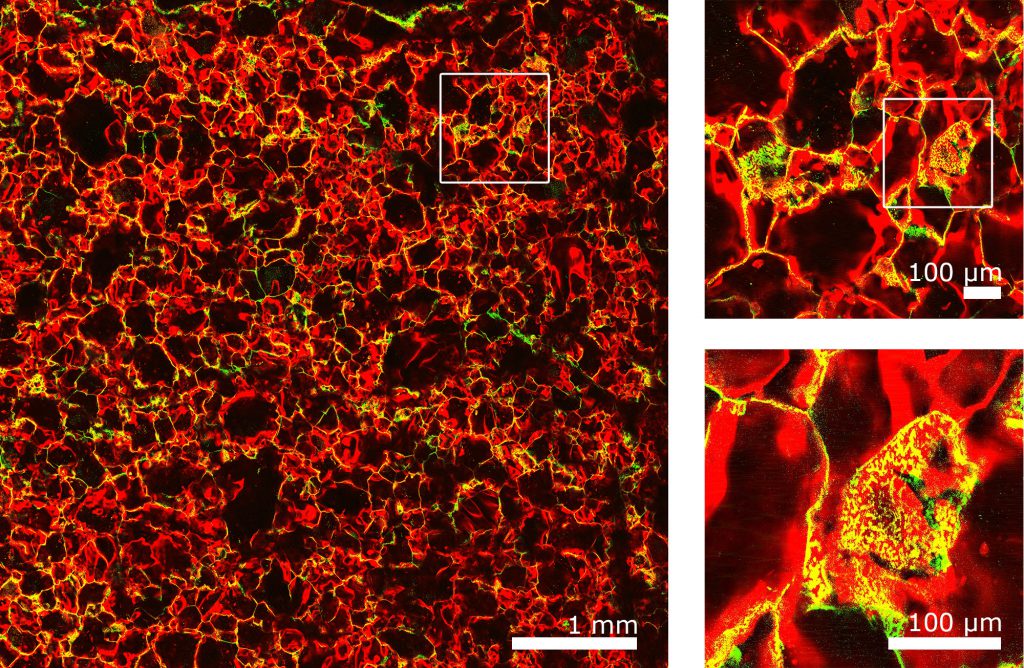3D Imaging of Gems and Minerals by Multiphoton Microscopy — Supplemental Images
Introduction
Here is a complete collection of images for all 36 samples. These pictures were taken as part of our project in studying Gems and Minerals with the Multiphoton Microscope, published in Optics Materials Express in 2019. The full sample collection can be seen in Fig. 1 from this paper. For each mineral, four images are presented. First, a picture of the sample itself from the collection that was purchased at the Tucson Gem and Mineral Show. Then, the images from the multiphoton are displayed, first SHG, then THG, then the composite image created with ImageJ, with SHG colored red, and THG colored green. These images were taken using a 20x .75 NA objective, and a 1040 nm laser. Additionally, general information about each mineral has been included, such as what each stone is made of. The location that each stone was found was labeled by the vendor. Each rock sample is 10 mm tall, 15 mm wide, and 2 mm deep. Each multiphoton image is 250 microns by 250 microns. If you have any questions regarding this project, please email us at bcromey@email.arizona.edu.
Large Stitched Images
Several large stitched images were made of some of the most interesting stones. These are included below with appropriate scale bars. The images were taken with the 20x .75 NA objective and the 1040 nm laser.
Orange Calcite
Blue Lace Agate
Gem and Mineral Zstack movies
Because of the file size restrictions on movies submitted to journals, the movies submitted showing the through focus images were very quick and low quality. The full file size moves are included here.
[arve url=”https://www.youtube.com/embed/RH-jAreFx-Q” aspect_ratio=”1:1″ /]
[arve url=”https://youtu.be/j6PxQ-afuUE” aspect_ratio=”1:1″ /]
[arve url=”https://youtu.be/3mNSf6-okJU” aspect_ratio=”1:1″ /]
Gem and Mineral Multiphoton Image Collection
Each multiphoton image is 250 microns by 250 microns in size.
Amazonite: Microcline feldspar
 Amethyst: Violet variety of quartz
Amethyst: Violet variety of quartz

Aventurine: Transluscent quartz

Blue Lace Agate: Considered a chalcedony (Silica, Quartz), formed volcanically
 Buttermilk Jasper: Quartz, silica, 20% random materials
Buttermilk Jasper: Quartz, silica, 20% random materials

Carnelian: Silica, quartz, iron oxide impurities

Dalmation Dacite: Feldspar, quartz, biotite, hornblende, pyroxine

Dumortierite: Fibrous aluminum boro-silicate material

Fancy Jasper: Considered a chalcedony, micro-granular quartz, silica

Flourite: Mineral form of clacium flouride

Gold Stone: Glittering glass, no crystal structure

Hematite: Mineral form of iron(III) oxide

Howlite: Calcium borosilicate hydroxide

Jadeite: Pyroxine Mineral

Lapis: Mixture of lazurite, huaynite, sodalite, noselite, calcite, pyrite

Leopard Skin Jasper: Micro-granular quartz and silica, 20% random materials

Mahogany Obsidian: Mainly silicon dioxide, small amounts of granite, rhyolite

Moss Agate: Chalcedony (quartz, silica), contains manganese/iron oxides

Nephrite: Variety of calcium, magnesium, and iron rich amphibole minerals

Obsidian: Lacks crystal structure, high silica content

Orange Calcite: Carbonate, formed under high temperatures

Picasso Jasper: Quartz, silica, 20% random materials

Picture Jasper: Quartz, silica, 20% random materials, unique patterns

Rainbow Jasper: Chalcedony, member or quartz group, contains clay/iron oxide

Red Jasper: Quartz, silica, 20% random materials

Rhodonite: Pink manganese silicate

Rhyolite: Igneous quartz, alkali feldspar, biotite, hornblende

Rock Crystal: Colorless quartz

Rose Quartz: Silicon, oxygen

Serpentine: Composed of one or more serpentine group minerals

Snowflake Obsidian: Silicon dioxide with impurities

Sodalite: Resembles feldspar with much less silica

Tiger eye stone: Silicon dioxide with parallel inter-growth of quartz

Tiger iron stone: Bands of hematite and jasper/quartz/chert

Turquoise: Hydrated phosphate of copper and aluminum

Unakite: Epidote with small amounts of quartz




